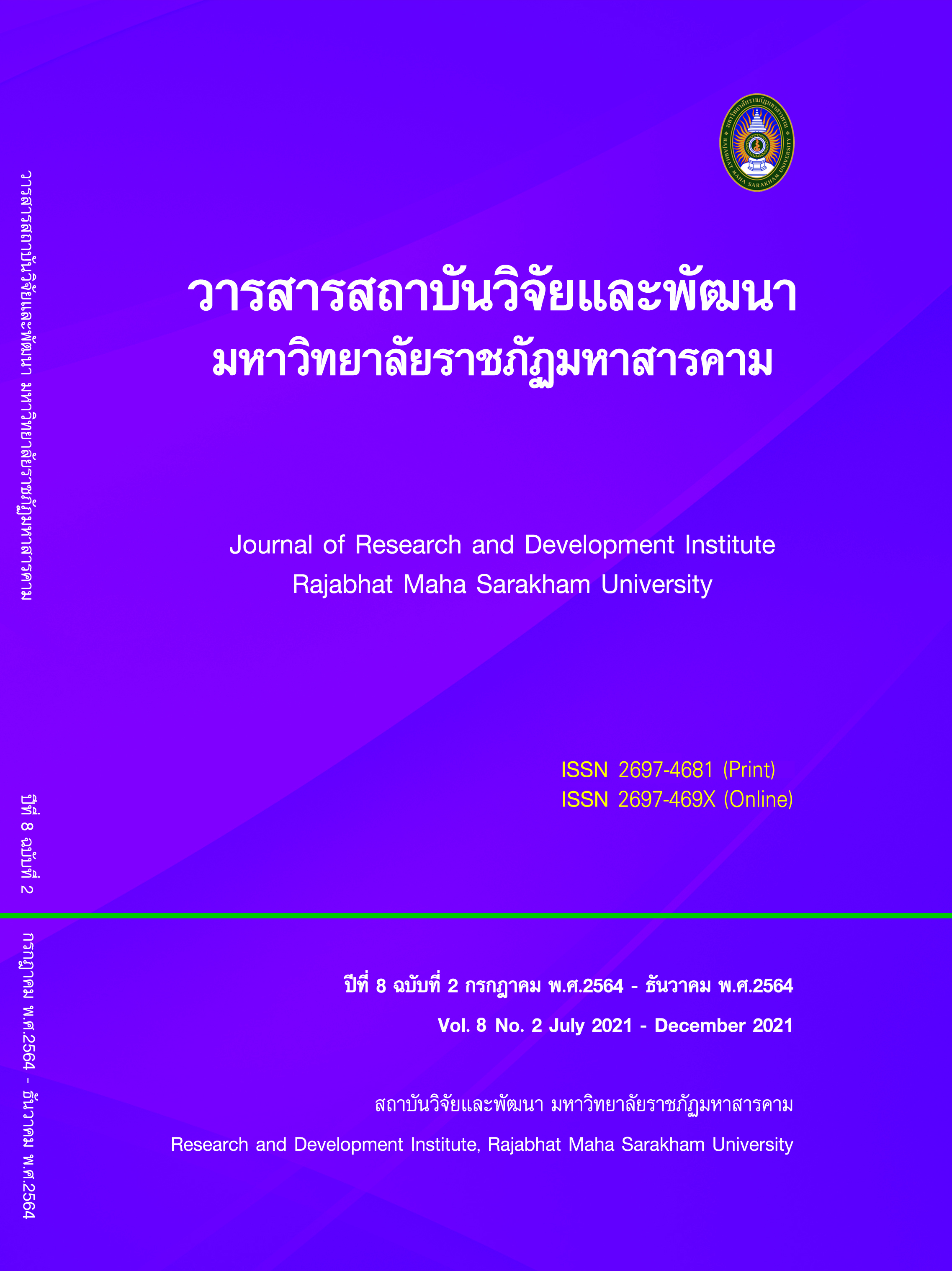Sacrificial Dance of Ku Bua Mat : Rituals and Beliefs of Bankok, Borabue District, Mahasarakham
Keywords:
Sacrificial Dance, Rituals, BeliefsAbstract
The Sacrificial Dance of Ku Bua Mat is a pattern for the Ban Kok Kok community to be used as a community show and it is also a continuation of local culture that shows the cultural identity of the community, it also promotes cultural tourism of the province as well. Therefore, this research has the objective (1) to study the rituals, beliefs of Ban Kok, Borabue District Maha Sarakham Province that affects Ku Bua Mat, (2) to create a show the Koo Bua Mat Sacrificial Dance. This research used qualitative research methods by collecting data from documents, collecting data from the field. By surveying, interviewing, observing, and discussing group discussions and analyzing data, the research results were found that
- Koo Bua Mat is the archaeological site in small Khmer culture, Located at Ban Kok Kok, Tambon Buamas, Amphur Borabue, Maha Sarakham Province. The architecture is a single castle, with a base, north connecting the main castle to enshrine Vishnu's idol which such architectural styles are rarely seen in the Khmer city of Phra Nakhon, creation it is not known how the belief in the creation was established. For the most part, religious places built in Khmer culture were Often built as a single castle alone for Lord Shiva, or built as three castles for Lord Shiva, Vishnu and Brahma respectively.
- The show the Koo Bua Mat Sacrificial Dance: principles of the invention in thinking for the dancer in the community. Defining key ideas at both target and objective levels, processing data, setting boundaries, formatting as well as defining other elements that include the costumes, the music, the dances, all are processes that control the work of the creation according to the purpose and concept which Creativity must include thoughtfulness, agility, flexibility, initiative, and tact.
References
Chanta, R. (2001). Folk Wisdom: Cultural Dimensions in Caring for HIV/AIDS Patients in Northern Thailand. Chiang Mai : Ming Muang Printing House.
Dechpimol, C. (1978). Reflections on the life of Isan people from Mo Lam. Bangkok: Department of Thai Language, Faculty of Arts, Silpakorn University.
Diskun, S. (1979). History of Southeast Asia to 2000. Bangkok: Office of the Prime Minister.
Guilford, J. P., & Hoepfner, R. (1971). The Analysis of intelligence. New York, NY McGraw-Hill Book Co.
Harnkam, S, (2004). Suriwong Isan Local Literature: An Analytical Study. Master of Thesis: Silpakorn University.
Hiranto, U. (1983). Encyclopedia of public administration (Public Administration). Bangkok: Odeon stro.
Kaewthongmee, P (Santimano). (2018). Religion and wisdom for local development. Mahasarakham : Mahasarakham University.
Kingmaee, A. (2000). Find traces of Khmer and Mon in Maha Sarakham. Maha Sarakham: Office of Arts and Culture, Maha Sarakham Rajabhat Institute.
Phukhamwong, P . (2014). A Study of Faith Value in the Prang Ku Kaeo Worship Ritual of Buddhists in the Ku Kaeo District Udonthani Province. Bangkok: Mahachulalongkornrajavidyalaya University.
Royal Academy. (1999). Dictionary of the Royal Institute 1999. Bangkok: Royal Institute.
Samlee and Nilwanpha, R. (2019). Interview. Mahasarakham: Department of Thai and Eastern Languages: Mahasarakham University.
Sukhavanich, C. (1995). The idea of inventing dance moves. College of Dramatic Arts, Fine Arts Department.
Wirunrak, S. (2001). Dramatic art periscope. (2nd ed). Bangkok: Department of Dramatic Arts Faculty of Fine and Applied Arts Chulalongkorn University.
Wongprasert, C. (1989). The art of dancing in the northeastern region. Mahasarakham: Academic Resources Office, Srinakharinwirot University, Maha Sarakham.
Downloads
Published
How to Cite
Issue
Section
License
Copyright (c) 2021 Journal of Research and Development Institute Rajabhat Maha Sarakham University

This work is licensed under a Creative Commons Attribution-NonCommercial-NoDerivatives 4.0 International License.
Articles that are published are copyrighted by the authors of the articles







